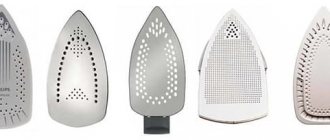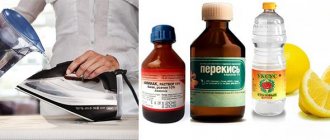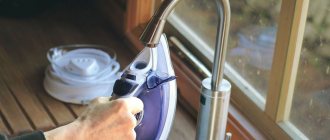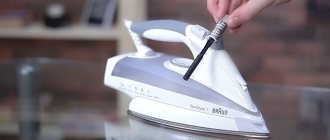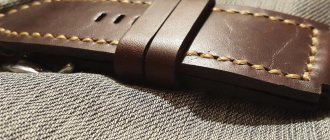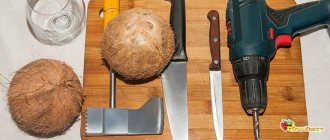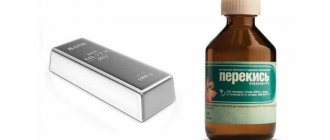Vinegar
Vinegar, which you probably have in your kitchen, will help you clean your iron from scorched fabric at home.
- Add two tablespoons of vinegar to a glass of water;
- Turn on the device and warm it up (so that you can touch it);
- Soak a natural cloth in the liquid and wipe the affected area.
There is an alternative method that will help with a large affected area:
- Dampen a rag with vinegar;
- Heat the device and unplug it from the socket;
- Place horizontally on a cloth and leave overnight;
- In the morning, wipe the sole with a soapy solution and rinse with clean water, then dry.
Please note that it is necessary to ensure good air circulation so as not to inhale vinegar fumes. Better open the window! Read also how to remove shine from an iron on clothes at the link.
The best folk remedies for cleaning carbon deposits
You can also clean a burnt iron using home methods. At the same time, a different product is suitable for each type of coating. For example, it is better to clean metal with toothpaste, soda and paraffin; stainless steel, ceramics and Teflon - toothpaste and vinegar.
Paraffin candle
Using a piece of soft cloth and a paraffin candle, you can quickly remove carbon deposits from the soleplate of your iron with your own hands. In addition, this technique also helps remove minor scratches.
Processing should be carried out according to the following scheme:
- the paraffin candle must be wrapped in cotton cloth;
- then you need to thoroughly rub the heated coating with the product until the paraffin melts and removes the burnt fabric.
This method must be used with extreme caution, since the heated paraffin mixture can cause burns or enter the device through the steam outlet holes. If paraffin particles flow inside the device, you can remove them by ironing a piece of cloth or paper sheet in the steaming mode.
Toothpaste and soda
Teeth cleaning paste can remove carbon deposits from almost any surface. But when using this product, you should take into account that it contains abrasive particles that can damage the sole if processed too frequently.
The paste should be used as follows:
- the sole is heated, after which paste is applied to it;
- the product is thoroughly rubbed with a brush;
- then the surface is washed with running water and wiped dry with a soft cloth.
To clean the steam vents, you can use ordinary cotton swabs.
Another effective folk method for cleaning an iron is baking soda. Apply a composition based on water and soda to the soleplate of the iron that is turned off. After 20 minutes, the mixture is wiped off the surface with a soft cloth.
With the help of baking soda and toothpaste, you can even get rid of old stains and stuck-on synthetic particles. But these substances will cause microcracks and scratches on the coating. Therefore, they should be used only in extreme cases, when other methods have failed to solve the problem.
Table vinegar
Acetic acid should be used in a room with good ventilation, since the fumes of this substance can cause discomfort and intoxication.
For processing you need to adhere to the following scheme:
- vinegar concentrate is diluted with water in a ratio of 1 to 1;
- a cotton cloth is moistened in the prepared solution, after which the heated sole is wiped with it;
- for ceramic-based coatings, you can add 4-6 drops of hydrogen peroxide to the solution. The substance will whiten the metal surface and return it to its former shine.
You can mix vinegar with ammonia and lemon juice. This home remedy will quickly and efficiently remove any carbon deposits.
Hydrogen peroxide
This folk remedy has proven itself to be effective in removing various contaminants. To process, you need to soak a cotton pad or ball in the solution, and then carefully treat the surface with it.
You can try to remove old carbon deposits with a solid form of peroxide - hydroperite. To do this, you just need to rub the surface with a hydroperite tablet and heat the sole. After cooling, the remnants of the drug are removed with a damp cloth, after which the surface is wiped dry.
When using this method indoors, all windows must be opened. The soleplate of the iron must be heated to maximum temperature before applying the substance.
Soap
Laundry soap is an effective and safe way to remove fresh carbon deposits. This product is not suitable for old stains because it does not have a sufficiently aggressive effect.
The surface of the iron needs to be heated, then rubbed with a bar of soap and left to cool completely. Contaminants are removed with a damp cloth.
You can also soak the fabric in the soap mixture and iron it with a heated sole. Holes in the coating should be cleaned with a toothpick or cotton swab.
To prevent the appearance of streaks, after using the device, you need to iron it with clean, moistened gauze.
Laundry soap
This method helps against new dirt; old stuck dirt cannot be removed. Do the following:
- Grate a small amount of soap;
- Add a little water to the shavings to make a paste;
- Apply the mixture to the surface using a soft sponge and leave for 20 minutes;
- Wipe off any residue with a damp cloth and dry with a towel.
How to remove traces of old heavy carbon deposits?
To remove significant, stubborn burnt stains and other contaminants, a method using hydroperite is suitable:
- crush the product into a fine powder (if you are cleaning the entire area of the sole, grind 10-12 tablets);
- heat the iron to maximum temperature: this stage is necessary for the hydroperite to become active upon contact with a hot surface and begin to release steam;
- distribute the powder evenly on the fabric, turn off the electrical device and place its sole on the preparation: you will see how the product begins to foam and dissolve;
- after a few seconds, place the iron vertically and clean off any remaining dirt with a damp cloth or sponge;
- Wipe the sole with a dry cloth.
ATTENTION! Be careful not to touch the hot ceramic coating with your hands!
Salt
When thinking about how and what to clean the iron from burnt fabric at home, do not forget about table salt, which is found in every home.
First way:
- Place two tablespoons of salt in a cotton bag;
- Heat the device and rub the dirty area.
Second way:
- Pour a glass of salt onto a hard, flat surface (board, cardboard);
- Turn on the device, heat it up and stroke the salt until the stains come off.
Salt has wonderful properties and is simply irreplaceable in the household (and not only for cooking). Let's discuss how else to clean the soleplate of the iron from burnt synthetics at home?
It is important to know how to clean an iron from burnt soles at home - more on that in another article.
Preventing contamination of the soleplate of the iron
- Study labels on clothes, find out the properties and characteristics of fabrics.
- Do not violate the temperature regime.
- Iron synthetic and woolen fabrics using a thin, damp cloth.
- Pour filtered water into the liquid reservoir.
- Every time after cooling, wipe the sole with a dry cloth.
- Clean once every six months, even if there are no obvious symptoms of burning.
- Proper care and careful attitude are the key to long and flawless service of a household appliance. The benefits are obvious: saving money and time, plus a good mood to boot.
Soda
Baking soda will help clean a burnt iron - follow this simple recipe:
- Warm up the device;
- Mix soda with water to make a paste;
- Apply it to contaminated areas and leave for 5-10 minutes;
- Then carefully remove the dried layer with a sponge and wipe with a dry towel.
Be careful not to press on the sole, as baking soda is an abrasive and can leave small scratches. We'll tell you which Philips iron is best to buy for your home in another relevant article.
Which irons can be cleaned in any way?
If an expensive Teflon-coated iron is burnt, it is better not to experiment with folk remedies. In such a situation, it is necessary to use a special cleaning agent. In addition, nothing bad will happen if the device is cleaned only after a few days.
To clean a burnt Soviet-made iron, which does not have special coatings or holes, you can use any means and methods.
Toothpaste
How to clean an iron from burnt fabric at home if you are afraid of scratching the material with soda? An excellent substitute is toothpaste, which acts more gently, but perfectly removes burnt-on remains.
- Apply the required amount of paste to a warm device;
- Use a soft brush to scrub away dirt;
- Wipe off the residue along with carbon deposits with a damp cloth or napkin.
Not all methods are suitable for Teflon, a surface with special properties. Therefore, we will separately discuss how to clean the iron from burnt non-stick fabric. We will answer the question of which is better: a steam generator or an iron in another review.
Types of coatings
When choosing a product to remove burnt fabric, you need to consider the coating material. The following types of iron soles are widely available:
- stainless steel;
- aluminum;
- ceramic;
- Teflon.
The first two types of soles are metal. To rid the surface of burnt surfaces, cleaning agents with hard particles - abrasives - are used. Do not use acids and acetone, as these substances can react with metal.
Ceramic and Teflon soles require delicate handling. After cleaning with abrasives, scratches remain on the iron, attracting small fibers of the fabric. As a result, the device sticks to clothes and linen even more strongly than before. You can wipe off carbon deposits using a special pencil or liquid solutions.
Non-stick sole
A surface with such properties is rarely subject to carbon deposits - but anything can happen. If you encounter a similar problem, you must:
- Buy a special pencil - they are sold in large stores;
- According to the instructions, rub the sole and remove any residue with a dry, clean cloth.
Alternative option:
- Wet a piece of cotton cloth with ice water;
- Wipe the problem area.
Often, the device comes with a special scraper that can be replaced with a wooden spatula.
Now you know how and with what to clean an iron from burnt fabric at home - our useful tips are based on the experience of many housewives and have been successfully used many times in everyday life. Read more: Which iron soleplate is the best? Find out the expert answer faster.
Rules for cleaning Teflon-coated irons
Teflon is a slippery and durable material that is used in the production of ironing electrical appliances. If the operating rules are violated, synthetics may stick and burn to such a reliable sole. To solve this problem, you should study the rules:
- Cleaning products that contain abrasives are aggressive and can make the problem worse. It is not recommended to use them.
- It is forbidden to clean Teflon surfaces with metal sponges or sandpaper.
- Suitable materials for removing dirt are cotton swabs or pads. Manufacturers additionally offer Teflon scrapers to remove stains or carbon deposits.
- Strictly follow the cleaning instructions and do everything with the power off.
Recommendations for care and use
To clean your iron rarely, follow a few recommendations:
- After each use, wipe the sole with a soft damp cloth;
- periodically clean the inside of the device from scale;
- When ironing things, you need to take into account the type of material: silk, wool and delicate fabrics cannot withstand high temperatures, so they will easily melt and stick;
- To clean the device, do not use metal sponges and brushes, they leave scratches;
- After each use, the remaining water should be poured out of the iron, then scale and rust inside will form more slowly.
When working with an iron, you must follow safety precautions: do not leave a hot device unattended, do not use it if the wire is damaged, do not touch the heated surface. If you receive burns, the burned part of the body must be placed under cold water for a few minutes, and then seek medical help.
Nail polish remover
A liquid with or without acetone is suitable. But when using this option to clean the iron, be careful: the liquid may damage the plastic parts. Therefore, it is best to apply the liquid pointwise, with a cotton swab or cotton pad. Simply rub the stain until it dissolves.
Treatment of titanium and sapphire coatings
Titanium and sapphire surfaces are considered the most resistant to damage, so they can be cleaned with harder substances. Both special and homemade products are suitable for this.
- Salt. You need to take a sheet of paper and sprinkle some salt on it. Heat the device to maximum and walk over the salt surface. To enhance the effect, you can add a little grated paraffin. After the procedure, the device must be wiped with a cloth. You can also iron gauze with salt if the deposit is slight. It is advisable to use this method infrequently; with regular use, the surface will be subject to mechanical damage, which will lead to its rapid wear.
- Paraffin. Wrap the candle in cotton material and heat the iron well. Next, rub the sole, tilting the device slightly so that the paraffin flows into the tray. You need to make sure that the heated candle does not fall into the steam holes. After completing the procedure, you must thoroughly wipe the surface of the product. This method allows you to polish the sole.
- Toothpaste. There is no need to heat the device. Apply the paste to the sole of the device and wait until it dries completely. Then wipe it with a cloth.
- Peroxide. It is necessary to heat the iron to maximum, wet the cloth, and iron it.
- Soda. You will need half a glass of warm water and one teaspoon of soda. Moisten a small piece of soft cloth in the resulting solution and treat the surface. If the stains are strong, you can apply the substance in its pure form and rub the stains with it.
- Matchbox. Cut out the sulfur coating from the matchbox and heat the device. Then gently scrub the surface.
Such remedies are effective, but you should not use them too often. This is especially true for soda and salt.
Cleaning with a pencil
A pencil is a universal, delicate and at the same time effective way to remove burnt fabric. The product is suitable for most types of surfaces. As a rule, it contains ammonia, so a characteristic odor may appear during cleaning.
How to use?
- Read the instructions.
- Turn on and heat the iron to the specified temperature.
- Draw a pencil over the hot surface. At the same time, try not to get it into the steam holes. During the cleaning process, dirt and carbon deposits will drain from the sole along with the melted product.
- When the iron has cooled, wipe off any remaining pencil with a clean, dry cloth.
Removing scale from inside
Almost all irons now come with steam - they are more convenient and efficient. During operation, scale forms inside - these are insoluble substances that water contains. They exist if undistilled water is poured into the iron. If the iron has a self-cleaning function, turn it on periodically. If not, you will have to act differently.
This is what was inside the steam iron
Cleaning from the inside
To remove scale from the iron, you need to pour acidified water inside. Scale is salts; an acidic environment corrodes them, they loosen and come out with steam. It is better to take water that is as purified as possible. Better - distilled. If it is not available, it can be boiled or after a good cleaning. Add citric acid to the water. For 200 ml - about 25 grams, per liter - 5-6 tablespoons. You can also add alcohol vinegar (one glass of 9% per liter), but it has a more unpleasant odor.
In order to clean the inside of the iron, you need to fill it with water and citric acid and turn it on until it heats up. And this is what comes out of there
Pour acidified water into the iron reservoir. In terms of quantity - to the maximum. Turn on the iron to maximum temperature. Heat until the light goes out twice or three times. Turn off the iron and go to the sink. We give him a good shake and let off some steam. If it has cooled down and there is still water inside, heat it up again, turn it off and continue cleaning.
The final stage is to pour in clean water and “evaporate” all of it. You can do this over an old impression rag. Usually, after observing what has accumulated inside, they forget to clean the iron less often.
Types of soles and features of their cleaning
Soles made of different metals have their own differences that affect the cleaning procedure.
Stainless steel
Stainless steel is a popular material in Russian-made irons. Steel conducts heat well, and ironing with this iron is very effective. But carbon deposits form on such surfaces more often than on others. That's why:
- should be cleaned regularly, at least once a year;
- It’s better not to wait for visible carbon deposits to appear, but to treat the surface while it’s still clean - the paste will help maintain the “mirror” polish of the sole and prevent tarnishing.
Aluminum
There are 2 types of aluminum on the soles of irons:
- ordinary;
- anodized.
Unfinished aluminum is similar to polished stainless steel, but is more susceptible to scratches. And these scratches make it difficult to iron thin synthetic fabrics. Therefore, it is worth cleaning such a surface with a paste without abrasives.
If a person knows for sure (from the instructions or passport of the iron) that the aluminum sole is anodized, then it can be cleaned with abrasives. This aluminum has been processed at high temperatures, is stronger than usual and is almost not deformed.
Titanium
Titanium soles are the most durable and stable. They can be rubbed with anything - titanium is not afraid of scratches at all. The disadvantage of irons is their reduced thermal conductivity, which wastes more electricity.
Teflon
Most imported irons use a protective Teflon coating. It protects the sole from burning, heats up quickly and glides well over the fabric. But the fragility of the protective layer greatly affects operation and cleaning:
- The composition of the toothpaste needs to be carefully studied - calcium, soda and other abrasive ingredients scratch Teflon, making it useless;
- When ironing, you should be careful with fasteners and decorations on fabrics - even a plastic button can leave a scratch;
- When applying the paste to the sole, it is better to use a soft natural cloth rather than a brush.
Ceramics
Ceramics and cermets are similar to Teflon and are also susceptible to scratches. They must be handled with the same care. The main difference between ceramics is that carbon deposits appear on it less actively; after the procedures, the sole remains clean longer.
Solutions for ceramics
The ceramic surface heats up quickly and smoothes things well, but it is very fragile and must be handled carefully. The appearance of scratches leads to deterioration in the operation of the device, therefore, when cleaning the soleplate, do not use abrasive substances or hard brushes.
The simplest and safest cleaning method is a special pencil containing ammonia. You need to warm up the device and then turn it off. Lubricate the surface with the product. After it dissolves, wipe the sole with a soft material. If there are steam holes, you must avoid getting the substance into them. You can also use products intended for certain types of surfaces and having different compositions.
If you don’t have a store-bought cleaner on hand, use homemade recipes.
- Vinegar. You need to warm up the device well and turn it off from the network. Using a rag, apply a little vinegar to the sole. You can clean the steam holes using ear cotton swabs soaked in the product. After completing the procedure, you need to turn on the electrical appliance and iron it with a cotton rag.
- Ammonia. It is necessary to mix ammonia and water in equal quantities. Take a sponge, soak it in the solution and wipe the contaminated areas. The iron preheats and is unplugged.
- Hydrogen peroxide. You should heat the iron to maximum, wet the rag in the census and iron it well. Perform these steps until the sole is completely clean. At the end of the procedure, remove dirt from the holes. The product allows you to remove scale.
- Nail polish remover. The surface of the iron should be slightly warm. Simply wipe it with a rag soaked in nail polish remover. This method helps to remove stuck fabric.
- Lemon juice or citric acid. You need to dilute the substance with water, dip a swab into it and wipe the surface.
Ceramic and Teflon soles should not be rubbed with hard brushes or treated with aggressive substances.
